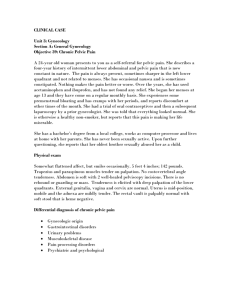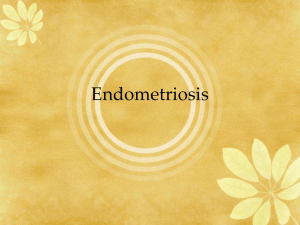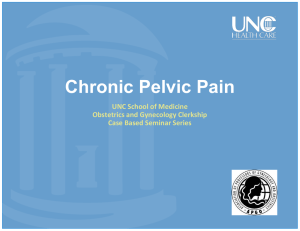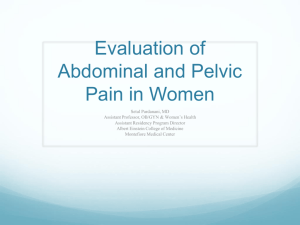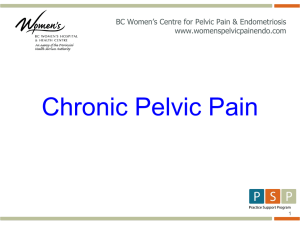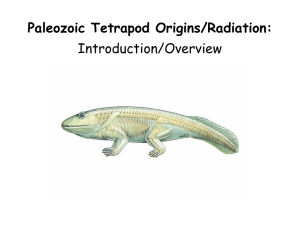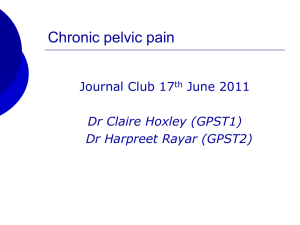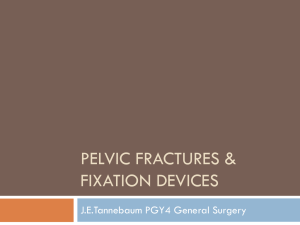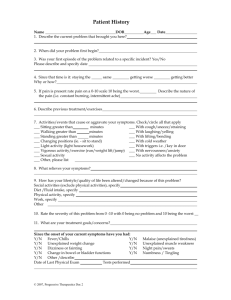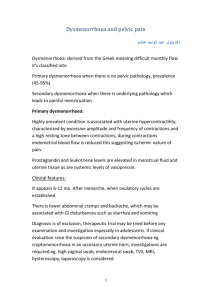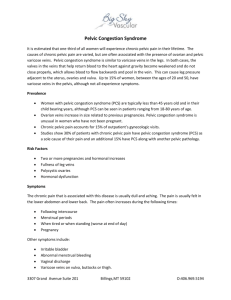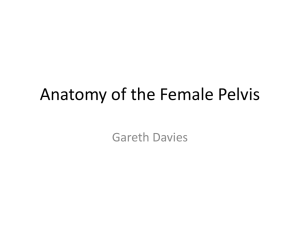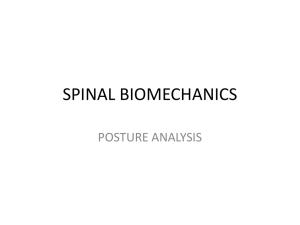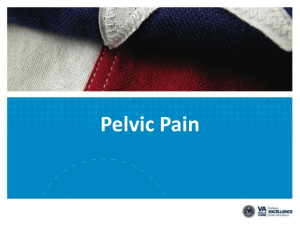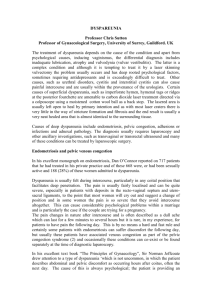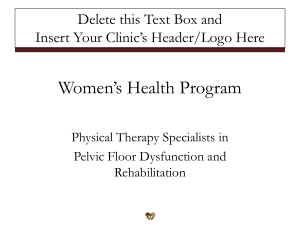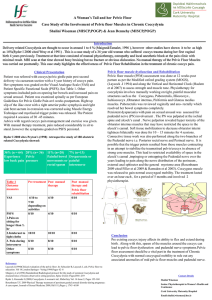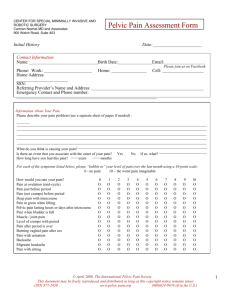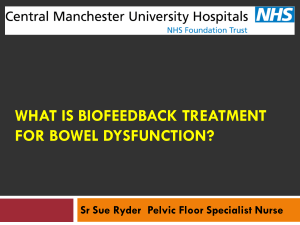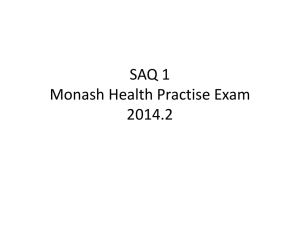Morning report CPP 22062012
advertisement
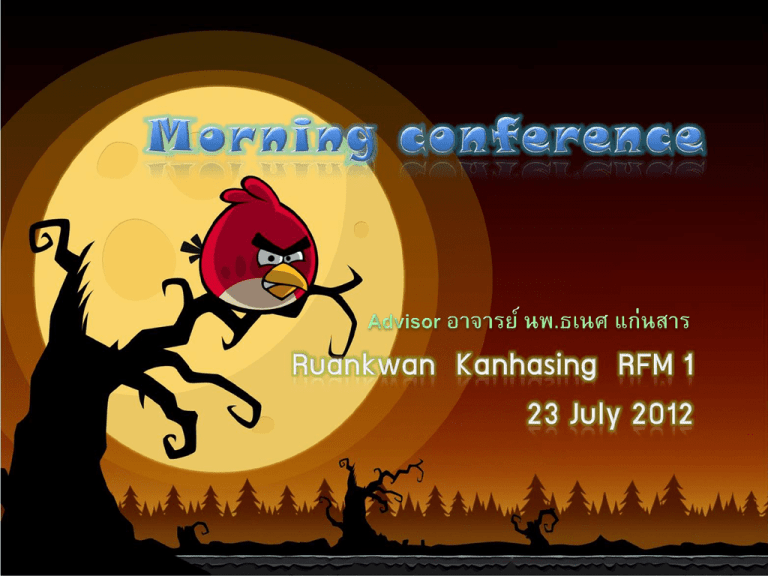
หญิงไทย อายุ 24 ปี อาชีพ เจ้าหน้าทีห่ อ้ งบัตร โรงพยาบาลเอกชน ภูมลิ าเนา จังหวัดมุกดาหาร ทีอ่ ยูป่ จั จุบนั จังหวัดสมุทรปราการ (หอพักโรงพยาบาล) 5 ปี PTA ทางานบริษทั เริม่ คบกับแฟนคนแรก (2548-2553) ทางานทีเ่ ดียวกัน มีเพศสัมพันธ์กนั สม่าเสมอ ไม่เจ็บ เวลามีเพศสัมพันธ์ มีปวดท้องน้อยนานๆ ครัง้ หลังมี เพศสัมพันธ์ แต่ไม่ทุกครัง้ เคยตรวจที่ รพ.เอกชน ด้วยเรื่องตกขาว วินิจฉัยเป็ นมดลูกอักเสบ ได้ยากิน อาการดีขน้ึ 2 ปี PTA ย้ายทีท่ างานมาอยู่ทโ่ี รงพยาบาลเอกชน ทางานเป็ น เจ้ า หน้ า ที่ ห้ อ งบั ต รตั ง้ แต่ เ วลา 7.00-19.00 น. ลักษณะงานเป็ นงานเอกสารและคอมพิว เตอร์สลับ ตาแหน่ งกันภายในแผนก ไม่มปี ญั หากับ ผู้ร่วมงาน รูส้ กึ สนุกกับงานทีท่ า 9 เดือน PTA เริม่ ปวดท้องน้ อยตรงกลางท้องบ่อยขึน้ ปวดบีบ เป็ นพักๆ ปวดทุกวันช่วงเวลา 15.00-19.00 น. ยังทางานได้ วันทีป่ วดมากมักร้าวขึน้ ลิ้นปี่ และมี ปสั สาวะบ่อยร่วมด้วย ไม่มปี สั สาวะแสบขัด ไม่ม ี เลือดปน ไม่มนี ิ่ว ไม่มตี กขาว อาการปวดท้ องไม่ สัมพันธ์กบั การกินอาหารหรือเหตุการณ์ท่ีทางาน หลังเข้านอนไม่เป็ น ไม่มี night pain นอนหลับได้ ปกติ 9 เดือน PTA ถ่ายอุจจาระ 2 วัน/ครัง้ ค่อนข้างแข็ง ไม่แสบก้น ไม่มถี ่ายเป็ นเลือด ไม่มี bowel habit change ประจาเดือนสมาสม่าเสมอทุก 28-30 วัน มาครัง้ ละ 3-5 วัน LMP 5/7/55 ไม่เคยปวดประจาเดือน ไม่ได้ถามประวัตคิ ุมกาเนิด 9 เดือน PTA รัก ษาที่ร พ.เอกชนที่ท างานอยู่ ได้ร บั การตรวจ (ต่อ) ร่างกาย ตรวจภายใน UA, TAS 2 ครัง้ โดยสูต-ิ นรี แพทย์, work up R/O KUB stone โดย ศั ล ยแพทย์ ห ลายครั ง้ ไม่ พ บความผิ ด ปกติ วินิจฉัยเป็ น pelvic pain, dysuria, dyspepsia เคยได้รบั การรักษาเป็ น NSAIDs, Hyoscine, Omeprazole หลายครัง้ อาการไม่ดขี น้ึ 9 เดือน PTA เริม่ รู้จกั แฟนคนปจั จุบนั เป็ นช่างเขียนแบบ โสด (ต่อ) ทางานคนละที ่ เจอกัน 1-2 ครัง้ /สัปดาห์ ทุกครัง้ ที ่ เจอกันทีบ่ า้ นของแฟน ค้างคืนด้วยกัน แต่ เพิง่ เริม่ มีเพศสัมพันธ์กนั เมือ่ 1-2 เดือน PTA ไม่เจ็บ แต่ก็ ไม่ถงึ จุด ... (59) Traumatic head injury S/P Sx ช่วยเหลือตนเองได้ 1st relation เลิกปี 2553 (55) (27) เขียนแบบ 2nd relation เริ่มปลายปี 2554 Room mate เจ้าหน้ าที่ห้องบัตร ปฏิเสธการแพ้ยา ปฏิเสธการแพ้อาหาร ปฏิเสธโรคประจาตัว ไม่เคยผ่าตัด ไม่ได้ใช้ยาใดเป็ นประจา นอกจากทีไ่ ด้จากโรงพยาบาล อาจจะปวดจากทางาน + เดินมาก ไม่น่าจะเกีย่ วกับเรือ่ งเพศสัมพันธ์ กลัวมีกอ้ นทีม่ ดลูก กลัวเป็ นโรครุนแรง ปกติ อยากรูว้ า่ เป็ นอะไรแน่ อยากหาย Vital signs BP 100/70 mmHg, BT ไม่ได้วดั PR 80/min, RR 20/min GA A young female, active HEENT No pale conjunctiva, no icteric sclera, no lymphadenopathy CVS Normal S1 and S2, no murmur RS Clear breath sound, no adventitious sound Abdomen Genitalia No distension, normal bowel sound, soft, not tender, no palpable mass PV - not test Previous exam at private hospital : unremarkable Extremities No edema, not seen rash or skin lesion Skin Not seen skin lesion or evidence of trauma ACOG Committee on Practice Bulletins. ACOG Practice Bulletin No. 51. Chronic pelvic pain. Obstet Gynecol 2004; 103:589–605. Chronic pelvic pain Cyclic (or noncyclic) pain that lasts longer than 6 month Localized to pelvis, anterior abdominal wall, below umbilicus or buttocks Sufficient severity to cause functional disability or required medical care Estrogen Depression Personality disorder Nociceptive pain Somatic (sharp pain) Visceral (dull pain) Non-nociceptive pain Neuropatic pain Psychogenic pain Allodynia Hyperalgesia A. B. C. D. Physical and sexual abuse Gynecologic problems Non gynecologic medical problems Psychologic al problems Bowel dysmotility Musculoskeletal dysfunction Depressive disorder Somatoform disorders Endometriosis Pelvic adhesions Dysmenorrhea and Mittelschmerz Chronic PID Gynecology Urologic Endometriosis Interstitial cystitis Pelvic adhesions Chronic UTI Pelvic varicosities Urethral syndrome Pelvic inflammatory disease Urinary calculi Adeomyosis Radiation cystitis Musculoskeletal Vulvodynia Uterine myomas Myofascial pain (abdominal wall or pelvic floor muscles) Ovarian cyst, ovarian tumor Coccygeal or low back pain Tuberculous salpingitis Nerve pain Gastrointestinal Psychological Irritable bowel syndrome Childhood physical or sexual abuse Inflammatory bowel disease Emotional abuse Chronic constipation Partner violence Malignancies Colitis Diverticulitis Post operative Adhesions Previous tubal ligation Bladder Gynecologic Colon 20-25 % of CCP (controversial role of pain) Cause Acute or chronic inflammatory disorder Physico-chemical trauma (surgery) 30% of CPP (12% in combination with another pelvic pathology) Pelvic congestion syndrome (PCS) Ovarian and pelvic (internal illiac) varicies Venous incompetence, reduced venous clearance in pelvis/ reflux Unknown pathophysiology Chronic pelvic, suprapubic, perineal, vulvo-vaginal pain, pressure with urinary urgency, diurnal frequency, nocturia Unknown caused Lt > Rt Exacerbation of pain : during or after sexual intercourse 10-15% overactive bladder Co-existing with endometriosis Functional dysmotility disorder of the bowel 65-79% of woman with CPP Uncertain etiology and multifactor pathophysiology Altered bowel motility Visceral hypersensitivity Psychosocial factor Pattern of the pain Associated symptom and red flag sign Previous surgery, child delivery Menstrual and contraception Life situation, abuse Patient’s affect General exam PV and focus on bladder and urethra Bimanual or rectovaginal examination Piriformis muscle Abdominal deformity “Carnett’s sign” Back and inguinal area Cervical cytology Endocervical cultures UA, urine culture Stool occult blood Pelvic ultrasound Laparoscopy Cystoscope Sigmoidoscopy/Colonoscopy +/- cancer screening, beta hCG Multimodal A strong physician-patient relationship Analgesics Acetamonophen NSAIDs Opioid analgesics Vitamin B1, Magnesium sulfate tablet Anticonvulsants : gabapentin, topiramate, valproic acid, pregabalin Botulinum toxin (Botox) injections Hormonal treatment Antidepressants : TCA, SSRI Lysis adhesion Hysterectomy Uterosacral nerve ablation CPP has similar to the prevalence of migraine, asthma and low back pain (in UK) 4 most common causes of CPP are (endometriosis) pelvic adhesions, pelvic varicies, interstitial cystitis, and irritable bowel syndrome. Women with CPP have more than one cause for their pain. Unclear what to do with the answers Unfamiliarity with treatment approaches Uncertainty about the next question Fear to offending patient Lack of obvious justification Generational obstacles Fear of sexual misconduct charge Sometimes perceived irrelevant Unfamiliarity with some sexual practices Morbidity and motality – STDs and HIV/AIDS Symptoms of illness Treatment side effects Past may explain present problems Function potentially lifelong Dysfunctions and difficulties are common Association with health and happiness Why not? May be negligent if ignored Ask patient PERMISSION Interviewer takes INITIATIVE LANGUAGE MEDICAL/TECHNICAL VS slang STATEMENT/QUESTION TECHNIQUE PRIVACY/CONFIDENTIALITY/SECURITY DELAY SENSITIVE QUESTIONS Display NONJUDGEMENTAL attitude Provide EXPLANATION Discuss FEELINGS Promote OPTIMISTIC ATTITUDE
